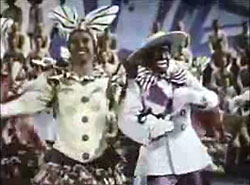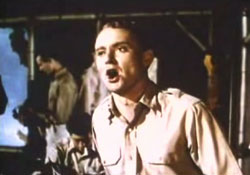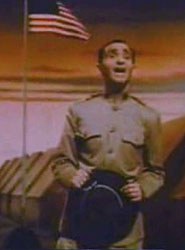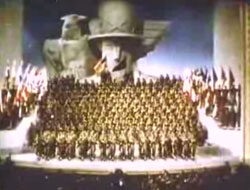 Directed by the US government to do their part for the war effort, Hollywood geared up for a few years of propaganda films, so proud of themselves they even called them propaganda films as the word "propaganda" had not yet taken on negative connotations of mistruth.
Directed by the US government to do their part for the war effort, Hollywood geared up for a few years of propaganda films, so proud of themselves they even called them propaganda films as the word "propaganda" had not yet taken on negative connotations of mistruth.
Some of the propogandistic films of the second world war were very thrilling, ranging from dramas to tearjerkers to lighthearted musicals, but more were rush-jobs that stank. Some of the biggest names of the given studio would make at least cameo appearances in bad films just to do their part for the war effort.
Before America got into the European theater, it was acceptable to make an anti-war film like All Quiet on the Western Front (1930), but once we were in it, the "messages" of the lamer films was "war is a fun musical" as in This is the Army (1943), or more credibly "the Marines are just so effing heroic" as in Sands of Iwo Jima (1949) & Battleground (1949), or more tragically "pacifists damned well better learn to fight the enemy" as in Sargeant York (1941) or "no degree of sacrifice is too much" as in the three-hanky-weeper The Fighting Sullivans (1944), & "American soldiers are the bravest dudes on earth" as in Twelve O'Clock High (1949).
Artful anti-war films like Paths of Glory (1957) for the most part would not be seen until World War II was over; & even "honest" war films waited for at least the war with Germany to be over beginning with The Best Years of Our Lives (1946) followed by such films as The Men (1950) focusing on the ruined lives of survivors, not to mention the array of anti-war films that arose in Russia after the war, & more still from Japan & the USA, from The Burmese Harp (Biruma no tategoto, 1956) to Dr. Strangelove (1964).
It was while Hollywood devoted itself to promoting war that This is the Army was dashed out to make the War seem not only necessary to support, but a cheery & polite war, no cause for worry, with singing & dancing & cross-dressing more than making up for the loss of a few friends or a slight limp. Burdsomely bad, sentiment held out long enough to earn it an Oscar for best music, though really the musical choices were terribly uneven.
 In 1918, Irving Berlin's wartime revue called Yip Yip Yaphank brought performing soldiers opened on Broadway, then again in 1943 he put together a review called This is the Army. Both reviews were drawn upon to create a new film version of This Is the Army.
In 1918, Irving Berlin's wartime revue called Yip Yip Yaphank brought performing soldiers opened on Broadway, then again in 1943 he put together a review called This is the Army. Both reviews were drawn upon to create a new film version of This Is the Army.
It opens in New York in 1917, with what will unexpectedly be the last performance of song & dance man Jerry Jones (played by future California senator George Murphy). While Jerry is singing the ragtime number "My Sweetie & Me" on stage, down the block Gertrude Niesen is on a little bandstand in uniform on the street singing "It's Your Country & My Country" to attract new recruits.
The show closes when the draft sweeps away too many entertainers, including Jerry, but never fear, they'll be able to put on a show for the Army, with a rendition of "Poor Little Me, I'm on KP" sung by George Tobias, warming us up for more of same.
This is the Army makes boot camp look like a lark with all soldiers just a little like Gomer Pyle & getting away with it. The cast is in the main totally lackluster & the singers for the most part only barely able to keep themselves from ruining even those few songs that could've been good ones from better voices.
The number "We're On Our Way to France" sung by the charcter of Jerry Jones helps shift the tale to the war front. When they reach France suddenly the Romantic Musical tone of the piece fizzles & we get a miniature piece of an horrific war film, momentarily about grimness & injury & smokily exploding battlefields & death. Then it's just as instantly Armistace, with bragging all around "we won the war to end all wars," no help from the Brits of course.
 To keep a bit of sorrow close to hand, the story has Jerry wounded in the leg, so that his career as a dancer is done. Tubby earthmother Kate Smith sings "God Bless America" on a postwar radio show, & thus climaxes the events of the Great War that was supposed to end all wars. To keep a bit of sorrow close to hand, the story has Jerry wounded in the leg, so that his career as a dancer is done. Tubby earthmother Kate Smith sings "God Bless America" on a postwar radio show, & thus climaxes the events of the Great War that was supposed to end all wars.
Jerry with some grey in his hair hasn't otherwise aged a day when America gets into the next World War. It's time for him to do another show for morale. As Part I of the film had been based on Irving Berlin's actual 1917 revue, Part II proceeds with bits of Berlin's 1943 equivalent, from which the movie takes its title.
The classic hero type, named Johnny of course, is played by Ronald Reagan, but fortunately we don't have to suffer much of him, despite that vhs & dvd boxes have for many years now implied he's the star. There's a bit more characterization & story for the WWII portion, but still & all, it's about the music.
Frances Langford sings "What does He Look Like that Boy of Mine" about a soldier learning his baby's born while daddy's far away at war. It's a bad song, though sung well.
Through all this I waited patiently for an actually worthwhile performance that was anything more than a patriotic fundraising advertisement in days of propaganda. Anything really good was very long in arriving, though a bit of merit eventually turns up.
After twenty-three years, survivors of the revue Yip Yip Yank are ready to do it again, the old timers directing their sons as stars of the revue, but including a moment for the old timers to shine as well. The pretty darned snappy tune "This is the Army Mr. Jones" is one of the highlights of the film, a good song, which can be said of surprisingly few of the numbers presented.
There's some bad stand-up comedy preceding the sentimental tenor Jimmy Burrell sings "I'm Getting Tired So I Can Sleep." Sargent Joe Lewis, the great boxer, got to be part of the show. President Roosevelt attends the show, depicted improbably standing up & walking.
 An appalling blackface minstrel routine serves as the "big" number with a lot of men dressed as bandanda'd mammies & the other half in tacky powder blue suits & white gloves, truly embarrassing both for the racism of it & because it's quite simply crap. "Mandy & Me" (sounding discomfittingly like "Mammy & Me") is sung by the Corporal Ralph Magelssen & a chorus, all of 'em black-face nightmares without a clue. An appalling blackface minstrel routine serves as the "big" number with a lot of men dressed as bandanda'd mammies & the other half in tacky powder blue suits & white gloves, truly embarrassing both for the racism of it & because it's quite simply crap. "Mandy & Me" (sounding discomfittingly like "Mammy & Me") is sung by the Corporal Ralph Magelssen & a chorus, all of 'em black-face nightmares without a clue.
A bit of "Way Down Upon the Swannee River" is hummed for the tapadancing, half of the guys dressed as mammies or Mandys, half dressed rather startlingly like Superflies, closing with a bit of jitterbug, all with an an enormous banjo in the background. Back stage, Alan Hale in officer uniform complains, "Grown up guys in dames clothes! If that ain't a sad sack of bananas!" which gets him quickly commissioned to do a drag routine himself.
Corporal John Prinze Mendes performs as a magician, cute fellow but horrible act with failing humor, & he's only in the film at all because it tries to crowd in a lot of actual soldiers, making this pretty much Amateur Night. "Ladies of the Chorus" is a big drag routine, very bad song, barely funny, with Alan Hale leading off the song.
Navy guys interupt Army guys singing "This is the Army Mister Jones" & builds to an enormous chorus line of guys in bell-bottoms & caps dancing & singing on a battleship. As if a chorus-line swabbies were already gay-icon enough, it really begins to look like gays were allowed in the armed forces back then when a third drag routine with overt drag queen comedy, & while everyone's in such a good mood, some terrible impersonations of Charles Boyer & Herbert Marshall by one more inconsquential talent.
Tenor Corporal Earl Oxford sings "I Left My Heart at the Stage Door Canteen" not to badly, certainly not as bad as most of this stuff, though the rhymy lyric is dorky: "I left my heart at the stagedoor Canteen/ I left it there with a girl called Eileen."
 The Air Corpe number follows. Sargent Robert Shanley leads off on "While I'm There in the Air With My Head in the Clouds," & he's very handsome, I assume one of the stand-out stars from the live stage version. The Air Corpe number follows. Sargent Robert Shanley leads off on "While I'm There in the Air With My Head in the Clouds," & he's very handsome, I assume one of the stand-out stars from the live stage version.
Sargent Shanley will also get the lead vocal on the rousing "American Eagles." It's elaborately staged with a plain on a forest airfield & cut-aways to little boys playing games, apparently to prepare the audience for the idea of these children going off to war the instant they turn eighteen, as even if this war ends there'll be plenty more for kids to die in.
Sargent Shanley will be back during the big finale as he & the flyers' chorus perform "This Time We Will All Make Certain." No other single member of the advertised "one-hundred actual soldiers" gets the special treatment Shandley gets, perhaps because he had had a tiny bit of Broadway experience before the war. His talent is just about justifies the attention, yet he seems never to have had any singing career after his time in the entertainment corp.
There's a fourth drag routine done by "Stump & Stumpy," a two-man comedy team you can see again in the black-cast movie Boarding House Blues (1948). In the '30s & '40s there were a number of singing, dancing, comedy duos with names like Moke & Poke, Son & Sonny, Chuck & Chuckles, Jesse & James, but of them all, Stump & Stumpy were well known to be the greatest.
It was frankly for the opportunity to see Stump & Stumpy that I bothered with This is the Army, & even though their act is a little embarrassing, at least a passel of white guys were doing sissy humor too.
And Stump & Stumpy unlike everyone else who performs do their act with super-charged energy & a great talent. They were a very popular live act of their day, & pretty much everyone agreed Martin & Lewis learned everything they knew from these guys.
 Corporal James Cross was in actuality nicknamed Spike among his friends, but in this act he was Stump. His transvestite partner is Eddie "Stumpy" Hartman (not Harold Cromer who became the new Stumpy several years later). James sings with great wit & charm "That's What the Well-dressed Man in Harlem Will Wear." He & Eddie do a highly acrobatic Lindy Hop with extraordinary vigour. For This is the Army they're certainly a high point of this lowly revue. Corporal James Cross was in actuality nicknamed Spike among his friends, but in this act he was Stump. His transvestite partner is Eddie "Stumpy" Hartman (not Harold Cromer who became the new Stumpy several years later). James sings with great wit & charm "That's What the Well-dressed Man in Harlem Will Wear." He & Eddie do a highly acrobatic Lindy Hop with extraordinary vigour. For This is the Army they're certainly a high point of this lowly revue.
The old guys from the 1917 show do a tapdance routine rendered "sentimental" because Jerry Jones has a gimpy leg & toughs it out to tap with his pals. And just before the film is winding down, the old guys are joined on st age by Irving Berlin himself!
Irving personally sings "Oh How I Hate to Get Up in the Morning." It's strange to say, but with all the mediocrity of the show, Irving turns out to be the best singer. His spot is just tremendous, almost worth the whole boring program. He's whimsical & yet very moving, providing what is probably the film's only moment of authenticity. If not for him & for the Stump & Stumpy spot, & perhaps for Kate Smith's too-obvioiusly lipsynched moment, there'd be nothing left to recommend This is the Army.
 We're then informed all these singers & dancers are being ordered back to their combat units, just before it all ends with a big number featuring losts of soldiers singing "This Time We Are Out to Finish the Job," with Busby Berkleyesque choreography. We're then informed all these singers & dancers are being ordered back to their combat units, just before it all ends with a big number featuring losts of soldiers singing "This Time We Are Out to Finish the Job," with Busby Berkleyesque choreography.
The choreography is unfortunately kind of fascist & dehumanizing, in front of a gigantic art deco eagle that would've made Mussolini swoon with joy. Kind of impressive, but one wonders if the film should've ended with Irving Berlin's spot, without the closing reminder that not much in the film transcended its propagandistic intent.
The original play, however, with "an all soldier cast," toured to great success both as a fundraiser for the Army Emergency Relief & to convince teenagers to sign on to the war, while uplifting the average citizen to see how much gosh-darned fun war can be. So the play's film adaptatin remains at least an historically important example of cinema's eager capacity to promote warfare.
copyright © by Paghat the Ratgirl
|

